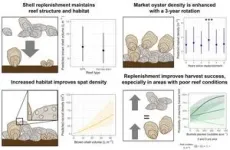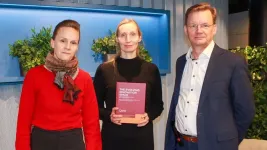(Press-News.org) Researchers of photonics from Tampere University, Finland, and Kastler-Brossel Laboratory, France, have demonstrated how self-imaging of light, a phenomenon known for nearly two centuries, can be applied to cylindrical systems, facilitating unprecedented control of light’s structure with great potential for advanced optical communication systems. In addition, a new type of space-time duality is explored for powerful analogies bridging different fields of optics.
In 1836, Henry F. Talbot performed an experiment, where he observed light patterns that naturally reappear after some propagation without the use of any lenses or imaging optics – a self-imaging phenomenon nowadays of then termed the Talbot effect.
Recently, researchers interested in sculpting light from the Experimental Quantum Optics Group (EQO) in Tampere University, as well as the Complex Media Optics group at Kastler Brossel Laboratory, in Ecole Normale Supérieure, Paris, have teamed up and investigated the self-imaging Talbot effect in cylindrical systems in greater depth than ever before. The presented interesting fundamental physics and powerful applications in optical communications have now been published in the prestigious Nature Photonics journal.
Exploring the effect of self-imaging in cylindrical geometries
Light travelling in a so-called ring-core fiber experiences a self-imaging process, albeit in angular position.
“As light enters the fiber at a specific angular position of the ring-like fiber core, it first spreads around the entire cylindrical core and then perfectly recombines to form the original field via the self-imaging process” explains Doctoral researcher Matias Eriksson, one of the leading authors of the study.
Importantly, this self-imaging in angular positions is only half of the fundamental phenomenon in cylindrical geometries. A similar interference effect also appears in a closely related property of light known as orbital angular momentum, which allows light to rotate particles around the optical axis, i.e., make them orbit on a ring-like path. Fundamentally, both properties, angular position and orbital angular momentum are considered complementary variables, which means that the precise definition of one leads to imprecision of the other property.
The team now combines the self-imaging in angle and orbital angular momentum for the first time in single experiment, for unprecedented control of the light’s spatial structure. But the study doesn’t stop there, the researchers also explore the intriguing connection to the time domain and demonstrate a powerful application for optical communication.
Bridging two popular fields in optics
A fundamental idea in optics is the so-called space-time duality, which suggests that many effects that are observed spatially, can also be seen in the light’s temporal structure. Based on this principle, the generalized self-imaging in time occurs for a periodic train of optical pulses and its corresponding frequency comb, i.e., light containing only well-defined and equally spaced frequencies.
In their work, the researchers unveil a new form of space-time duality by showing the strong link between angle/angular momentum and time/frequency.
“This means that the physical phenomena observed in these two fields are broadly connected, and the processing techniques from one may be used for the other” explains the other leading author Jianqi Hu, who was a postdoc fellow at Kastler Brossel Laboratory and is currently a researcher at École Polytechnique Fédérale de Lausanne, Switzerland.
Fundamental effect triggers application in optical communication
Benefiting from this deeper fundamental insight into self-imaging and its accompanying advanced modulation capabilities, the researchers additionally demonstrate a powerful application for optical communication.
“The generalized self-imaging effect can be cleverly tuned to encode, convert, and decode information in the light’s orbital angular momentum values such that they can act as independent communication channels,” says Eriksson.
As such, the current study shows that the theoretical promise of a loss-less and crosstalk-free operation for a vastly increased data rate is within reach, which could have a profound impact on the future of optical telecommunications.
The study on the generalized self-imaging effect in angle and angular momentum is now featured in the article Generalized angle–orbital angular momentum Talbot effect and modulo mode sorting published in Nature Photonics.
END
Self-imaging of structured light in new dimensions
2025-02-21
ELSE PRESS RELEASES FROM THIS DATE:
Study highlights successes of Virginia’s oyster restoration efforts
2025-02-21
Virginia has made significant investments in the restoration of oyster reefs in the Chesapeake Bay, and now a study led by William & Mary’s Batten School & VIMS suggests those management practices are literally paying off in the Rappahannock River. The study, recently published in the Journal of Environmental Management, was led by Batten School of Coastal & Marine Sciences Ph.D. student Alexandria Marquardt, who presented the results to the Virginia Marine Resources Commission’s (VMRC) Shellfish Management Advisory Committee ...
Optimism can encourage healthy habits
2025-02-21
Do you see the glass as half empty or half full? If you rewind to the start of the COVID-19 pandemic, chances are you experienced some level of pessimism. And who could blame you? With social isolation, health concerns and economic uncertainty, fear and anxiety became a daily reality for many.
A team of researchers from Syracuse University and Michigan State University recently explored the personal characteristics that help people handle prolonged stressors, such as the pandemic. Led by Jeewon Oh, assistant professor of psychology in Syracuse University’s College ...
Precision therapy with microbubbles
2025-02-21
The targeted treatment of brain diseases such as Alzheimer’s, Parkinson’s or brain tumours is challenging because the brain is a particularly sensitive organ that is well protected. That’s why researchers are working on ways of delivering drugs to the brain precisely, via the bloodstream. The aim is to overcome the blood-brain barrier which normally only allows certain nutrients and oxygen to pass through.
Microbubbles that react to ultrasound are a particularly promising method for this sort of ...
LLM-based web application scanner recognizes tasks and workflows
2025-02-21
A new automated web application scanner autonomously understands and executes tasks and workflows on web applications. The tool named YuraScanner harnesses the world knowledge stored in Large Language Models (LLMs) to navigate through web applications in the same way a human user would. It is capable of working through tasks in a coherent fashion, performing the correct sequence of steps as required by, for example, an online shop. YuraScanner was tested against 20 web applications, unearthing 12 zero-day cross-site scripting (XSS) vulnerabilities. The technique behind YuraScanner as well as the tool itself have been developed by researchers ...
Pattern of compounds in blood may indicate severity of gestational hypertension and preeclampsia
2025-02-21
Preeclampsia, a complication of pregnancy characterized by high blood pressure and high levels of protein in the urine (proteinuria), indicating damage to the kidneys or other organ damage, is the main cause of maternal-fetal death in Brazil and the runner-up worldwide. In a Brazilian study published in the journal PLOS ONE, the pattern of substances present in patient blood samples varied according to the severity of the preeclampsia concerned.
The findings from the study, which was supported by FAPESP, ...
How does innovation policy respond to the challenges of a changing world?
2025-02-21
Researchers from the University of Vaasa, Finland, and Kent Business School, UK, have gathered insights on innovation policy, its current status and future perspectives in their new book “The Evolving Innovation Space”. The book offers research-based insights on how innovation can best be used to drive economic change and to find solutions to global problems.
– In a changing world, where geopolitical tensions are rising and artificial intelligence is gaining ground, innovation policy must also be reconsidered from new perspectives, says Helka Kalliomäki, one of the editors.
With digital ...
What happens when a diet targets ultra-processed foods?
2025-02-21
Most dietary programs are designed to help people achieve weight loss or adhere to U.S. nutrition guidelines, which currently make no mention of ultra-processed foods (UPFs). UPFs – like chips or candy – are the mass-produced, packaged products that contain little or no naturally occurring foods. Eating UPFs is strongly associated with increased risk of diseases and early death.
Because almost no existing programs focus specifically on reducing UPF intake, researchers from Drexel University’s College of Arts and Sciences designed an intervention that included a variety of tactics to target the uniquely problematic ...
University of Vaasa, Finland, conducts research on utilizing buildings as energy sources
2025-02-21
The University of Vaasa has received funding from Business Finland for the FlexiPower research and development project, which focuses on developing and commercializing the "Building as a Battery" (BaaB) solution. The project aims to find solutions that utilize existing building infrastructure as flexible energy sources.
The goal of the FlexiPower project is to develop and commercialize a solution that enables the dynamic response of building heating and cooling systems to the needs of the power system. This innovation offers a cost-effective and scalable solution for balancing the power grid without significant initial ...
Stealth virus: Zika virus builds tunnels to covertly infect cells of the placenta
2025-02-21
Infection with Zika virus in pregnancy can lead to neurological disorders, fetal abnormalities and fetal death. Until now, how the virus manages to cross the placenta, which nurtures the developing fetus and forms a strong barrier against microbes and chemicals that could harm the fetus, has not been clear. Researchers at Baylor College of Medicine with collaborators at Pennsylvania State University report in Nature Communications a strategy Zika virus uses to covertly spread in placental cells, raising little alarm in the immune system.
“The Zika virus, which is transmitted by mosquitoes, triggered an epidemic in the Americas that began in 2015 and ...
The rising tide of sand mining: a growing threat to marine life
2025-02-21
In the delicate balancing act between human development and protecting the fragile natural world, sand is weighing down the scales on the human side.
A group of international scientists in this week’s journal One Earth are calling for balancing those scales to better identify the significant damage sand extraction across the world heaps upon marine biodiversity. The first step: acknowledging sand and gravel (discussed as sand in this publication) – the world’s most extracted solid materials by mass – are a threat hiding in plain sight.
“Sand is a critical resource that shapes the built and ...







